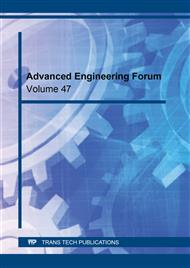[1]
J. Yadav, S. Tiwari, Influence of crumb rubber on the geotechnical properties of clayey soil, Environment, Development and Sustainability, 20(6) (2018) 2565-2586.
DOI: 10.1007/s10668-017-0005-y
Google Scholar
[2]
E. Kalkan, Preparation of scrap tire rubber fiber–silica fume mixtures for modification of clayey soils, Applied Clay Science, 80 (2013) 117-125.
DOI: 10.1016/j.clay.2013.06.014
Google Scholar
[3]
C. Nilna, S. Chandrakaran, Stabilization of Soft Clay Using Nylon Fiber and Fly Ash, in: Ground Improvement and Reinforced Soil Structures, Springer, 2022, pp.51-58.
DOI: 10.1007/978-981-16-1831-4_5
Google Scholar
[4]
S. Li, D. Li, Mechanical properties of scrap tire crumbs-clayey soil mixtures determined by laboratory tests, Advances in Materials Science and Engineering, 2018 (2018).
DOI: 10.1155/2018/1742676
Google Scholar
[5]
C.A. Jaafar, I. Zainol, N. Ishak, R. Ilyas, S. Sapuan, Effects of the liquid natural rubber (LNR) on mechanical properties and microstructure of epoxy/silica/kenaf hybrid composite for potential automotive applications, Journal of Materials Research and Technology, 12 (2021) 1026-1038.
DOI: 10.1016/j.jmrt.2021.03.020
Google Scholar
[6]
M. Mrad, R. El-Samra, Waste tire management: Lebanon case study, Journal of Waste Management and Disposal, 3(1) (2020) 101.
Google Scholar
[7]
L. Jimoda, I. Sulaymon, A. Alade, G. Adebayo, Assessment of environmental impact of open burning of scrap tyres on ambient air quality, International Journal of Environmental Science and Technology, 15(6) (2018) 1323-1330.
DOI: 10.1007/s13762-017-1498-5
Google Scholar
[8]
A. Mohajerani, L. Burnett, J.V. Smith, S. Markovski, G. Rodwell, M.T. Rahman, H. Kurmus, M. Mirzababaei, A. Arulrajah, S. Horpibulsuk, Recycling waste rubber tyres in construction materials and associated environmental considerations: A review, Resources, Conservation and Recycling, 155 (2020) 104679.
DOI: 10.1016/j.resconrec.2020.104679
Google Scholar
[9]
N. Alvarez, J. Gutierrez, G. Duran, L. Pacheco, Experimental study of the mechanical effect of a clayey soil by adding rubber powder for geotechnical applications, in: IOP Conference Series: Materials Science and Engineering, IOP Publishing, 2020, p.012057.
DOI: 10.1088/1757-899x/758/1/012057
Google Scholar
[10]
D.N. Humphrey, Effectiveness of design guidelines for use of tire derived aggregate as lightweight embankment fill, in: Recycled materials in geotechnics, 2005, pp.61-74.
DOI: 10.1061/40756(149)4
Google Scholar
[11]
M. Warith, S.M. Rao, Predicting the compressibility behaviour of tire shred samples for landfill applications, Waste Management, 26(3) (2006) 268-276.
DOI: 10.1016/j.wasman.2005.04.011
Google Scholar
[12]
H. Moo-Young, K. Sellasie, D. Zeroka, G. Sabnis, Physical and chemical properties of recycled tire shreds for use in construction, Journal of Environmental Engineering, 129(10) (2003) 921-929.
DOI: 10.1061/(asce)0733-9372(2003)129:10(921)
Google Scholar
[13]
U. Balunaini, S. Yoon, M. Prezzi, R. Salgado, Pullout response of uniaxial geogrid in tire shred–sand mixtures, Geotechnical and Geological Engineering, 32(2) (2014) 505-523.
DOI: 10.1007/s10706-014-9731-1
Google Scholar
[14]
S.B. Malegole, P. Pranab, Sustainable use of recycled concrete aggregates and waste rubber shreds in drainage layer of landfills, Japanese Geotechnical Society Special Publication, 9(5) (2021) 221-225.
DOI: 10.3208/jgssp.v09.cpeg066
Google Scholar
[15]
A. Arefnia, A. Dehghanbanadaki, K.A. Kassim, Sustainable Implementation of Recycled Tire-Derived Aggregate as a Lightweight Backfill for Retaining Walls, KSCE Journal of Civil Engineering, 25(11) (2021) 4196-4206.
DOI: 10.1007/s12205-021-0218-3
Google Scholar
[16]
M. Zadehmohamad, J.B. Bazaz, R. Riahipour, V. Farhangi, Physical modeling of the long-term behavior of integral abutment bridge backfill reinforced with tire-rubber, International Journal of Geo-Engineering, 12(1) (2021) 1-19.
DOI: 10.1186/s40703-021-00163-2
Google Scholar
[17]
H. Djadouni, H. Trouzine, A. Gomes Correia, T.F.d.S. Miranda, 2D numerical analysis of a cantilever retaining wall backfilled with sand–tire chips mixtures, European Journal of Environmental and Civil Engineering, 25(6) (2021) 1119-1135.
DOI: 10.1080/19648189.2019.1570870
Google Scholar
[18]
H. El Naggar, A. Iranikhah, Evaluation of the Shear Strength Behavior of TDA Mixed with Fine and Coarse Aggregates for Backfilling around Buried Structures, Sustainability, 13(9) (2021) 5087.
DOI: 10.3390/su13095087
Google Scholar
[19]
N. Hataf, M. Rahimi, Experimental investigation of bearing capacity of sand reinforced with randomly distributed tire shreds, Construction and building materials, 20(10) (2006) 910-916.
DOI: 10.1016/j.conbuildmat.2005.06.019
Google Scholar
[20]
H. Sellaf, H. Trouzine, M. Hamhami, A. Asroun, Geotechnical properties of rubber tires and sediments mixtures, Engineering, Technology & Applied Science Research, 4(2) (2014) 618-624.
DOI: 10.48084/etasr.424
Google Scholar
[21]
P. NF, 94-056-Analyse granulométrique par tamisage-Méthode par tamisage à sec après lavage, Norme Française, AFNOR, Paris, (1996).
Google Scholar
[22]
N. AFNOR, P94-051-Sols: reconnaissance et essais; Détermination des limites d'Atterberg–Limite de liquidité à la coupelle-Limite de plasticité au rouleau, Association Française de Normalisation, Paris, France, (1993).
Google Scholar
[23]
P. NF, 94–050,(1995), Sols: reconnaissance et essais. Détermination de la teneur en eau pondérale des matériaux. Méthode par étuvage. AFNOR, Paris.
Google Scholar
[24]
N. AFNOR, Détermination de la masse volumique de particules solides des sols. Méthode du pycnomètre à eau, in, NF P94-054, (1991).
Google Scholar
[25]
N.P. 94-093, Sols: reconnaissance et essais–Détermination des caractéristiques de compactage d'un sol, essai Proctor normal et modifié, in, AFNOR France, (1999).
Google Scholar
[26]
N. P94-071-1, Soil: Investigation and testing–direct shear test with shear box apparatus–part 1: Direct shear, in, Association Française de Normalisation France, (1994).
Google Scholar
[27]
K. Yin, A.-L. Fauchille, E. Di Filippo, P. Kotronis, G. Sciarra, A Review of Sand–Clay Mixture and Soil–Structure Interface Direct Shear Test, Geotechnics, 1(2) (2021) 260-306.
DOI: 10.3390/geotechnics1020014
Google Scholar


